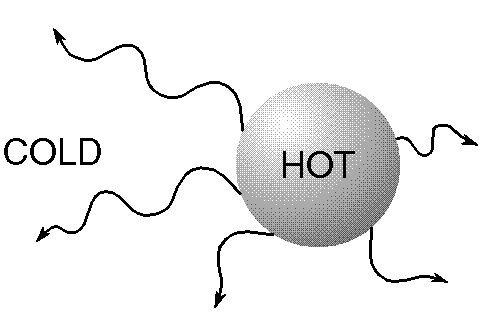
Video lecture for Atmospheres section

Planet atmospheres slow down the rate that heat escapes from a planet's surface or interior, as well as, distribute heat over a planet's surface. Because there is a temperature difference between the surface or interior of a planet and space, heat energy will flow from the warmer surface to the cold space. How well an atmosphere transfers heat and the methods it uses will have a profound effect on the surface temperature and weather. There are three ways gases can transfer energy:

It is a sort of "energy conveyor belt" motion of gas. Nature will use convection only if there is a large change in temperature over a small distance (a "steep temperature gradient"). Such conditions are found in planet atmospheres (compared to size of a planet, atmospheres are very thin!) and the interiors of stars.
In addition to transporting energy outward to space, convection also distributes the heat across the planet, from the warm daylit equatorial regions to the cooler latitudes closer to the poles and to the night side of the planet. The warm air at the equatorial regions rises and the cooler air from other parts of the planet flows across the surface toward the equator to replace the rising air. All of the winds in a planet's atmosphere are due to convective processes. If the planet is rotating quickly enough, the motion of the air can be deflected sideways by the Coriolis effect (see also the Galileo section in the history chapter).
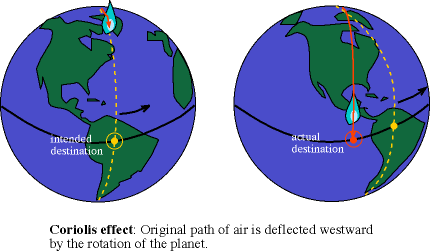
If a pocket of air from the pole moves toward the equator without changing direction, the Earth will rotate beneath it. The packet of air has a sideways motion equal to the rotation speed at the pole, but the parts of the Earth's surface closer to the equator have a greater rotational speed because they are farther from the rotation axis. To an observer on the ground, the path appears deflected to the west. The Coriolis effect on a spherical body is actually a bit more complicated than just the east or west deflection described above but a more complete treatment of the Coriolis effect requires higher level physics beyond the scope of this textbook. For our purposes, it is sufficient to say that objects will be deflected to the right in the northern hemisphere and to the left in the southern hemisphere, even for objects traveling due east or due west. The Coriolis deflections produce the spiral patterns of cyclonic storms (winds spiraling inward counter-clockwise in the northern hemisphere and clockwise in the southern hemisphere) and air flow away from high-pressure regions (winds rotate clockwise in the northern hemisphere and counter-clockwise in the southern hemisphere).
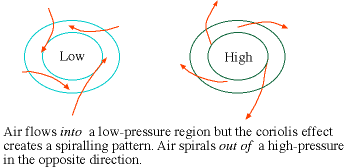
Some nice animations of air circulation around low and high pressure regions are available from NASA's Visible Earth site: low-pressure circulation animation -- high-pressure circulation animation.
The rapid rotation of a planet will also complicate the convective flow of energy from the warm equator to the cool poles. On a planet with little or no rotation (Venus, for example), the air circulation is very simple: warm air rises along the equator, flows at high altitudes toward the poles, and near the surface returns to the equator. On a planet with rapid rotation (Earth or the jovian planets, for example), the surface winds from the poles are deflected into large-scale eddies with belts of wind and calm. At high altitudes narrow bands of high-speed winds called jet streams are formed and they play an important role on the surface weather. Land masses sticking up into the air flow disrupt the spiraling circulation and provide a place for storms to expend their energy.
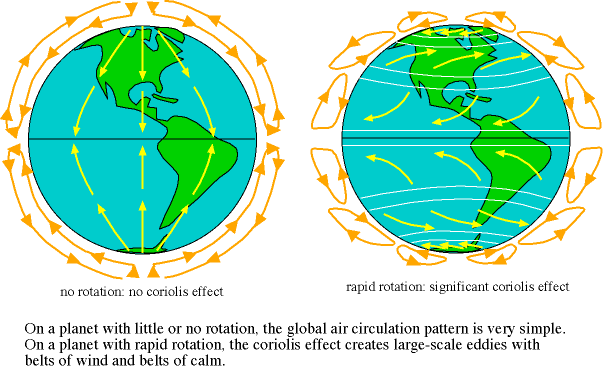
The rapidly rotating jovian planets have much greater Coriolis effects. The powerful, narrow jet streams deflect the clouds into belts moving parallel to the planet equators. The winds in a belt move in the opposite direction of the belt next to it. Large vortices can form from the interplay of the belts. A large vortex can last for decades, even centuries or longer because the jovian planets do not have a solid surface for storms to expend their energy. Jupiter's Great Red Spot is an example of a large vortex. Twice the size of the Earth, it is at least 400 years old.
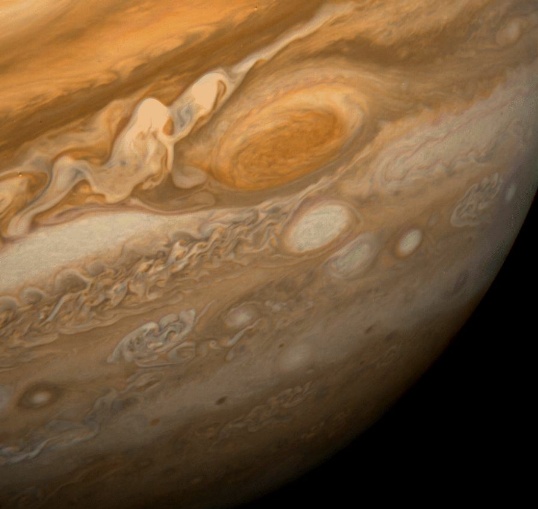
For most of the planets, the Sun provides the energy to maintain the temperature (and surface temperature for the terrestrial planets) and to drive the convective motions of the atmosphere. But Jupiter, Saturn, and Neptune generate over twice as much heat than they receive from the Sun. Most of this energy is leftover heat from when the planets formed 4.6 billion years ago. As material collected onto the forming planets, it heated up when energy was released by the material falling in the planet's gravity field. All of the planets were hot enough to be liquid. The heavier, denser materials (like iron and nickel) separated from the lighter materials (like silicon, hydrogen, and helium) and fell toward the planet cores. The process called differentiation released more gravitational energy and heated up the planets further. Due to their large size, the jovian planets still retain a lot of their initial formation heat and that energy is responsible for the spectacular clouds patterns. In the case of Saturn, the differentiation process may still be going on as the helium in the interior separates from the hydrogen and sinks toward the core, a "helium rain". The helium rain is probably why there is a smaller percentage of helium in Saturn's atmosphere than in Jupiter's atmosphere.
The much blander atmosphere of Uranus is a result of its lower heat emission. Most of the heat inside the much smaller Earth and Venus is produced from radioactivity in the rocky material (in fact, the higher radioactive heating long ago may have been necessary for the terrestial planets to undergo differentiation). However, the heat of Venus' and Earth's interior has little to zero effect on their atmospheres because the crust is such a poor conductor of heat (though convection in their interiors is responsible for the geologic processes seen on their surfaces). Sunlight energy is what determines their surface temperatures and drives their weather.
Atmospheres moderate the heat lost to space at night and shield the planet surface from energetic radiation like solar ultraviolet and X-rays and the high-speed charged particles in solar wind and most cosmic rays (extremely high-energy particles from space, mostly protons). The planet Mercury has almost no atmosphere and so there is a difference of several hundred degrees between places in the shade and sunlit areas! The planet Mars has a very thin atmosphere, so it experiences a temperature drop of over a 100 degrees when night comes. Humans landing on the martian surface will need to contend with the extreme cold of the night and will need to protect themselves from the harmful solar radiation during the day. The Earth's atmosphere is thick enough that the temperature difference between night and day is at most a few tens of degrees. Our atmosphere also blocks high-energy light like UV and X-rays and solar wind particles. Some cosmic ray particles have high enough energy to penetrate the atmosphere and even several meters of rock! If a cosmic ray strikes the DNA in the cells, the DNA structure can be altered. Cosmic rays are responsible for some of the genetic mutations in life.
![]() Go back to previous section --
Go back to previous section --
![]() Go to next section
Go to next section
last updated: March 20, 2022